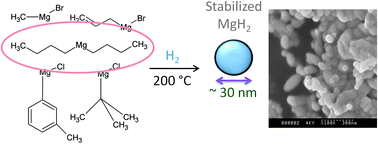Remarkable hydrogen storage properties for nanocrystalline MgH2 synthesised by the hydrogenolysis of Grignard reagents†
Abstract
The possibility of generating MgH2

* Corresponding authors
a
Merlin group, ARC Center for Functional Nanomaterials, School of Chemical Engineering, The University of New South Wales, Sydney NSW 2052, Australia
E-mail:
f.aguey@unsw.edu.au
Fax: +61 (0)2 938 55966
Tel: +61 (0)2 938 57970
b Center for Advanced Macromolecular Design, School of Chemical Engineering, The University of New South Wales, Sydney NSW 2052, Australia
The possibility of generating MgH2

 Please wait while we load your content...
Something went wrong. Try again?
Please wait while we load your content...
Something went wrong. Try again?
E. J. Setijadi, C. Boyer and K. Aguey-Zinsou, Phys. Chem. Chem. Phys., 2012, 14, 11386 DOI: 10.1039/C2CP41140G
To request permission to reproduce material from this article, please go to the Copyright Clearance Center request page.
If you are an author contributing to an RSC publication, you do not need to request permission provided correct acknowledgement is given.
If you are the author of this article, you do not need to request permission to reproduce figures and diagrams provided correct acknowledgement is given. If you want to reproduce the whole article in a third-party publication (excluding your thesis/dissertation for which permission is not required) please go to the Copyright Clearance Center request page.
Read more about how to correctly acknowledge RSC content.
 Fetching data from CrossRef.
Fetching data from CrossRef.
This may take some time to load.
Loading related content
